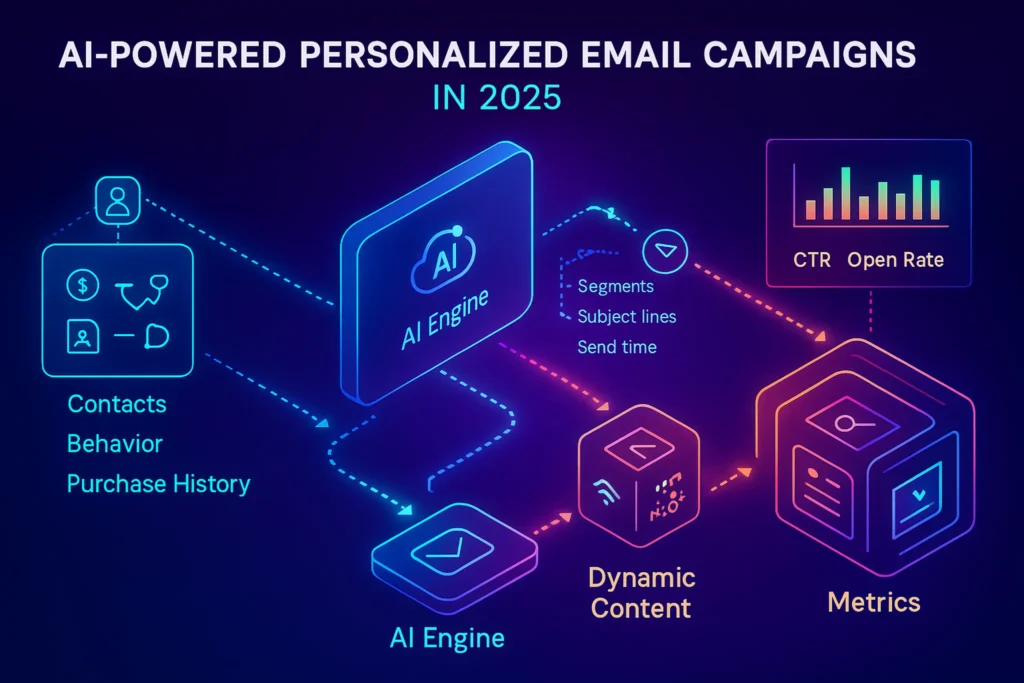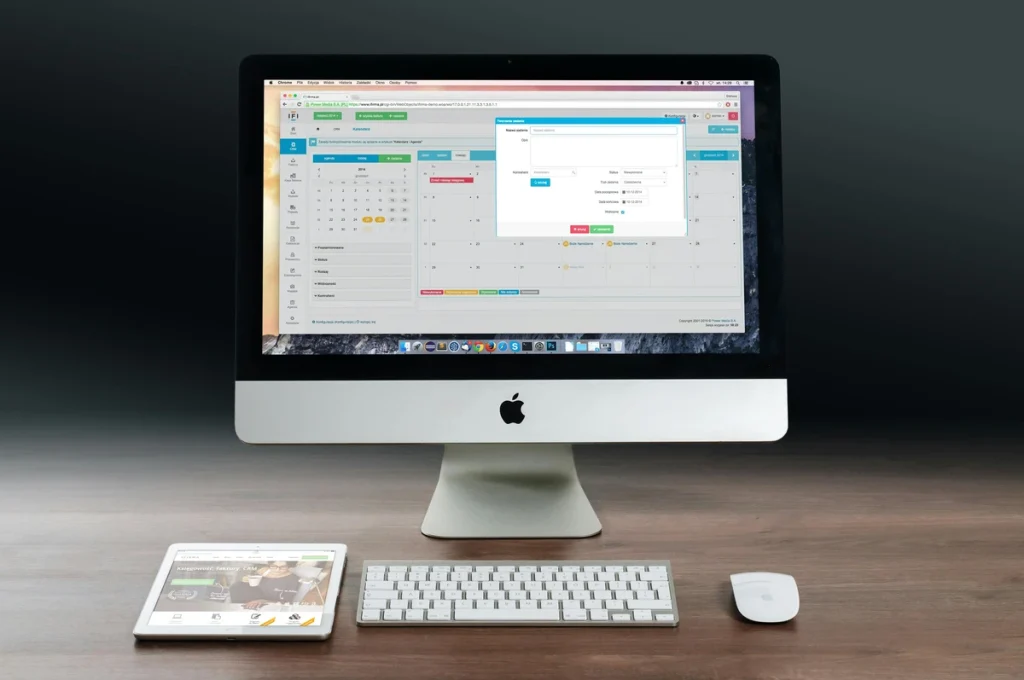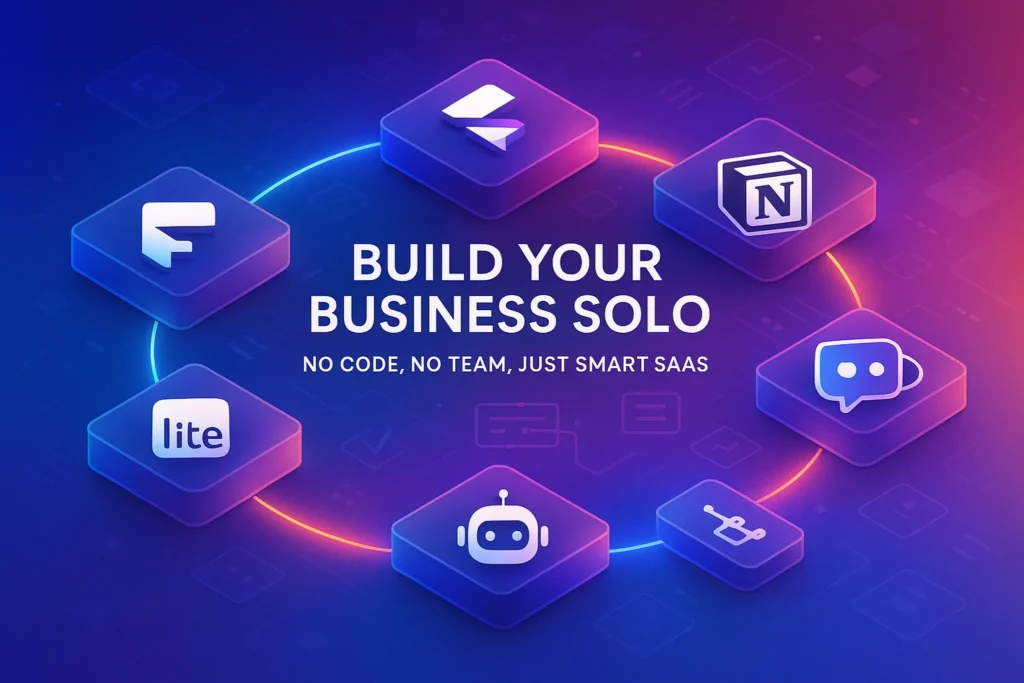🎯 Why personalization is non-negotiable in 2025
Inbox competition didn’t slow down—algorithms did. ISPs increasingly weigh engagement and recipient satisfaction to decide inbox vs. promotions vs. spam. That means “spray-and-pray” campaigns not only convert worse; they actively risk your sender reputation. Personalization fixes that by linking intent to context: who the person is, what they care about, and what they just did. When done right, you get higher opens/clicks, better conversions, and fewer spam complaints, because each message feels like it belongs.
AI makes this achievable at scale. Instead of hand-building dozens of tiny segments, you can let models suggest dynamic subject lines, swap content blocks per user profile, select predictive send times, and trigger follow-ups based on behavior—all from the data you already have. Modern ESPs (Mailchimp, HubSpot, Klaviyo, Brevo/Sendinblue, ActiveCampaign—and Kit, formerly ConvertKit) ship these capabilities in the box or as add-ons, so even a lean team can run “enterprise-grade” personalization. Mailchimp’s Content Optimizer and Send Time Optimization are clear examples on the SMB end, while HubSpot layers in lead scoring and AI assistants tied to CRM data; Klaviyo leans into predictive analytics and Smart Send Time for ecommerce.
💬 Personalization isn’t a trick; it’s respect. “Here is the most useful thing for you, right now.”
🧠 What AI can actually do in your emails (and what it can’t)
Think of AI as a set of programmable instincts. It doesn’t replace strategy or brand voice—it amplifies them with timeliness and relevance. The reliable wins fall into five buckets:
1) Dynamic subject lines.
Subject lines still move mountains, but testing them manually is slow. AI can generate variations from your brief and pick a likely winner for each audience—or even personalize the variant per recipient if your ESP supports it. ActiveCampaign’s Predictive Content uses natural language models to choose which of your variants each contact sees based on past clicks; other tools recommend subject lines to A/B test at scale.
2) Content blocks per user profile.
Inside one email you can swap modules: top hero for VIPs, education for new subscribers, category-specific tiles for known preferences. Some ESPs pair this with catalog feeds or “recommended for you.” Klaviyo’s predictive features (CLV, churn risk) and AI segmentation make content decisions easier; ActiveCampaign mixes predictive with conditional content; Mailchimp gives AI-assisted layout and copy nudges via the Content Optimizer.
3) Predictive send times.
Stop guessing the “best time to send.” Models analyze open patterns and schedule each contact’s delivery when they’re most likely to engage. Mailchimp and HubSpot both market this explicitly; ActiveCampaign calls it Predictive Sending; Klaviyo frames similar capabilities around smart send time. This one upgrade alone stabilizes open rates and protects deliverability.
4) AI-powered segmentation.
Instead of granular manual filters, ask for “people likely to buy again this month,” “high AOV window shoppers,” or “newsletter readers who never click product links.” Klaviyo and HubSpot highlight AI-assisted segmentation; Brevo and Mailchimp expose similar workflows in their marketing suites with AI assist for content and timing.
5) Behavior-triggered follow-ups.
AI makes triggers smarter: it can decide whether a browse-abandon warrant a reminder, whether to escalate with an incentive, or whether silence signals churn. The ESP’s job is the automation; the AI’s job is the decision boundary (who gets which follow-up, when, and with what tone). This pairs beautifully with the lifecycle flows we mapped in Email Automation for Shopify Store Owners.
What AI can’t do: write your positioning, decide your ethics, or fix list quality. Garbage in, garbage out—so feed it clean events, consented lists, and brand guidelines.
📬 Get the Personalization Starter Kit (AI + ESP Presets)
Join our free newsletter and receive a print-ready toolkit to personalize emails that convert:
subject-line prompts, dynamic content block recipes (ecommerce/SaaS/creators), predictive send setup,
14-day measurement plan, and a quick deliverability checklist (SPF/DKIM/DMARC).
🔐 100% privacy. No spam. Just actionable email playbooks from NerdChips.
🛠️ Step-by-step workflow (from zero to personalized in a week)
You don’t need a martech overhaul. Start with your current ESP; if it lacks key AI features, switch later with a migration plan. Here’s a practical week-one rollout:
✅ Step 1 — Pick an AI-enabled ESP (or confirm your current one is ready)
You want three must-haves: predictive send time, content personalization, and AI-assisted segmentation. Mailchimp offers Content Optimizer + send-time tools; HubSpot Marketing Hub layers CRM-level AI; Klaviyo focuses on ecommerce predictions and smart send time; Brevo (Sendinblue) positions itself as an AI-enabled multichannel suite; ActiveCampaign offers Predictive Content and Predictive Sending; Kit (formerly ConvertKit) emphasizes creator workflows with emerging AI aids. If you’re shopping or benchmarking, we’ve compared stacks in 10 Best Email Marketing Tools and taken a neutral look in HubSpot vs Mailchimp for teams that want CRM-tight vs campaign-first.
✅ Step 2 — Train the model with the right data
AI can’t infer what you never send it. Wire in behavioral events (opens, clicks, URL categories), commerce (products, AOV, velocity), and profile data (region, language, lifecycle stage). Label your content library by intent (educate, compare, convert) so the system can match blocks to profiles. For ecommerce, push catalog/product feed and tag buyers by category affinity. For SaaS, feed trial milestones and feature usage. For blogs/newsletters, tag readers by topic interest.
Give your ESP verbs (“browsed”, “watched”, “compared”)—not just nouns.
✅ Step 3 — Start with one campaign and two AI assists
Pick a revenue-adjacent campaign (e.g., new-subscriber welcome, post-purchase cross-sell, or educational “starter kit”). Keep the email structure fixed but let AI handle subject line variants and predictive send times. That’s enough to see lift without risking your voice. In parallel, define two audience slices: a high-intent segment (recent clicks or add-to-cart) and a nurture segment (reads but never clicks). You’ll swap one content block between these slices in Step 4.
✅ Step 4 — Add a single dynamic content block
Inside the email, swap one module: a product-recommendation tile for buyers vs. an explainer block for first-timers; a “start trial” CTA vs. a “see pricing” CTA for evaluators. Resist the temptation to make everything dynamic; the point is to observe the lift from one smart swap. If your ESP supports it, use a predictive block so each recipient gets the variant most likely to earn a click (ActiveCampaign’s Predictive Content is a canonical example).
✅ Step 5 — Layer behavior-triggered follow-ups
Now that the seed email runs, add two triggers: (1) if the recipient clicked but didn’t convert within 48 hours, send a short “nudge” tailored to their click category; (2) if they didn’t open at all, resend with the second-best AI subject line at their predicted time. This is where predictive send time shines: it gives your second attempt the best shot across time zones and habits. Mailchimp, HubSpot, Klaviyo, ActiveCampaign, and Brevo all document variations of this approach under send-time optimization or smart send features.
If you want performance reporting without spreadsheet purgatory, have a peek at How to Automate Your Marketing Reports for ways to pipe these results into a single dashboard.
📊 Three case examples (hands-on and specific)
1) E-commerce: post-purchase to second purchase
Goal: move first-time buyers to second order within 30 days.
Plan: predictive send time for day-7 care email; dynamic block with recommended accessories (if high-price item) or refills (if consumable); behavioral follow-up if they browse but don’t buy.
Execution notes: in Klaviyo, combine predicted CLV with category affinity to choose between “premium cross-sell” and “refill reminder.” In ActiveCampaign, load two short variants into a Predictive Content block. In Mailchimp, use Content Optimizer insights to adjust copy length and CTAs for mobile skimmers.
2) SaaS: onboarding within the first 14 days
Goal: get a free trial user to an “aha” moment (e.g., first successful project).
Plan: AI segmentation splits users into “stuck on step 1”, “exploring integrations”, “invited teammates.”
Execution notes: send a role-specific subject line variant (“Connect X in 2 minutes” vs “Invite your first teammate”) and predictive sending at typical work hours by region. HubSpot’s CRM tie-in helps here; ActiveCampaign and Brevo can replicate the timing and variant logic for non-HubSpot stacks.
Goal: increase click-through on curated links without clickbait.
Plan: keep your voice; let AI reorder or highlight the two links each subscriber is most likely to tap, using interest tags and past clicks.
Execution notes: in creator-centric tools (Kit, formerly ConvertKit), lean on tags and automations to simulate predictive content; in Mailchimp/Klaviyo, use AI-assisted subject lines and smart send to lift opens, then a small dynamic block (“Top pick for you”).
🎨 Checklist: 5 AI personalization tactics to test this week
A checklist only after proper explanation, now condensed for execution:
-
Turn on predictive send time for one high-impact campaign; compare opens over 2 weeks vs. your baseline. (Mailchimp, HubSpot, Klaviyo, ActiveCampaign, Brevo).
-
Add one dynamic content block using either rules (new vs returning) or predictive selection. Measure click lift on that module. (ActiveCampaign Predictive Content is the template).
-
AI-generate 3 subject lines from your brief; A/B against your control for two sends. Keep the winner as a reusable style. (Mailchimp/Klaviyo/HubSpot have assistants).
-
AI segmentation: ask for “likely to buy in 30 days” or “reads, doesn’t click”; send a short experiment to each, not your whole list. (Klaviyo predictive analytics; HubSpot AI).
-
Behavior triggers: resend unopened with a different AI subject line at predicted time; nudge clickers with a context-aware follow-up. (All ESPs named above support variants of this).
💬 One campaign, two AI assists, one week. Learn, then scale.
🎨 Mini-comparison: ESPs with notable AI personalization
Quick read: choose based on your data backbone and use case.
| ESP | Notable AI Personalization | Where it shines |
|---|---|---|
| Mailchimp | Content Optimizer (AI suggestions), Send Time Optimization | Fast setup for SMB; copy/layout guidance + timing. |
| HubSpot | AI assistants tied to CRM, predictive scoring, send-time insights | Companies needing CRM-native personalization across the funnel. |
| Klaviyo | Predictive analytics (CLV, churn), Smart Send Time, AI segmentation | Ecommerce with rich catalog/behavioral data. |
| Brevo (Sendinblue) | AI content assists + send-time optimization | Budget-friendly multichannel (email/SMS/WhatsApp). |
| ActiveCampaign | Predictive Content (NLP variant selection), Predictive Sending | Rule-plus-model hybrid personalization in automations. |
| Kit (formerly ConvertKit) | Creator-centric automations; emerging AI aids | Solo creators/newsletters; keep expectations modest on AI depth. |
Inference note: Feature names and positioning vary by plan; always confirm availability on your tier.
🧱 Data quality, deliverability, and privacy (the unsexy edge)
AI personalization only works if your inputs are clean and consented. Standardize naming (events, tags), consolidate duplicate contacts, and maintain a suppression list for bounces/complaints. Respect privacy: use AI for relevance, not creepiness. Keep PII in your own systems; pass only what the ESP needs to personalize ethically. AI can raise engagement—deliverability still requires authentication (SPF, DKIM, DMARC), consistent volume, and helpful content. If reporting is getting unwieldy, our How to Automate Your Marketing Reports can help you stitch ESP dashboards into one truth.
🧪 Testing plan: how to prove lift (and not fool yourself)
Run A/Bs with enough volume to matter (use ESP calculators) and isolate one variable at a time. For predictive send time, split by recipient, not by send time block; for dynamic content, instrument link-level clicks to tie lift to the module. Beware false wins from list churn (e.g., you pruned in week 2). Log your experiments in a simple sheet: hypothesis, setup, sample size, 3 metrics (open-rate, click-through, conversion). Repeat monthly with fresh subject and a new dynamic block. Over a quarter you’ll stack compounding improvements without whiplash.
🧰 Playbooks you can copy (and adapt in 30 minutes)
Welcome series with AI:
Email 1: brand story + AI subject variants; predictive send time.
Email 2: dynamic module—education vs. offer based on signup source.
Email 3: behavior-triggered branch—clicked product? show relevant proof; no click? send “getting started” guide.
Re-engagement drip:
Segment “no opens 90 days,” exclude purchasers. Send a value-dense email with personalized highlights; predictive sending on. If no open, auto-sunset in 30 days with a final opt-in reminder. (Protects deliverability and trains algorithms that your list stays healthy.)
SaaS onboarding nudge:
If the user hasn’t hit the activation event, send a role-aware tip (admin vs. end-user) with a contextual CTA. If clicked/no activation in 24h, send a short video. Predictive time ensures work-hour delivery by locale.
If you sell online, pair these with our ecommerce-specific tactics in Email Automation for Shopify Store Owners for cart and post-purchase wins.
🎯🧠 Nerd Picks for AI-Powered Personalization
💡 Start where your data already lives. These ESPs pair clean personalization with real-world automation and reporting.
Built for stores: AI segments, product feeds, and predictive analytics that slot right into your flows.
Personalize with first-party CRM data, predictive scoring, and AI assistants across the full funnel.
Quick to deploy for small teams; AI nudges for copy/design plus timing that boosts opens.
Let the model pick the best content variant and delivery time for each contact—inside your automations.
Email, SMS, and WhatsApp under one roof—send-time optimization without heavy lift or heavy cost.
Clean tagging and sequences with lightweight AI aids—great for solo newsletters and course launches.
🧠 Nerd Verdict
AI-powered personalization isn’t a moonshot—it’s a series of small, durable wins. Turn on predictive send time, add one dynamic block, and let AI-assisted segments keep the message relevant. Measure cleanly, keep your brand voice human, and scale what proves itself. Do that for a quarter and you’ll feel the compounding effect in both revenue and reputation.
❓ FAQ: Nerds Ask, We Answer
💬 Would You Bite?
Tell me your ESP and one campaign you’d love to fix—welcome, post-purchase, or re-engagement.
I’ll map a 5-step AI personalization plan you can launch next week. 👇



